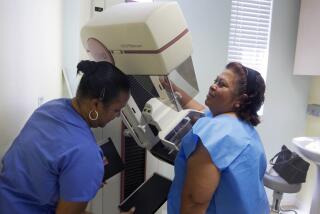Three thoughtful critiques of the recommendation against PSA testing
- Share via
When the U.S. Preventive Services Task Force issued a draft report this month recommending that men with no symptoms of prostate cancer stop using the PSA test to screen for the disease, the task force members surely braced themselves for some serious criticism. And it came swiftly – from urologists who administer the tests routinely, from men (and their loved ones) who believe the test saved their lives, and from opponents of healthcare reform who viewed the report as another attempt to ration medical services, among others.
It’s been a few weeks now, and more critiques of the task force’s report were published online Wednesday by the New England Journal of Medicine.
Before we get to them, let’s recap what the task force said, and why:
The PSA test measures the level of a protein called prostate specific antigen circulating in the blood. Levels that are high or rapidly rising can be a sign of prostate tumor growth, so men with worrisome numbers typically follow up with a biopsy to test for cancer cells. If they are found, they can proceed to treatment, which may include surgery, radiation, chemotherapy or hormone therapy.
The problem with this approach is that PSA, by itself, is not very good at predicting whether a man has prostate cancer. About two-thirds of men with higher PSA levels don’t have prostate cancer; meanwhile, about one-third of men with low levels that are usually considered “safe” actually do have the disease. In addition, prostate cancer is very often harmless – a disease that men die with, not of. But the treatment for prostate cancer can cause side effects like urinary problems and erectile dysfunction in 20% to 30% of patients.
All in all, the task force concluded, the downsides of screening outweigh the benefits. And they were certain enough of this finding to issue a grade of D, meaning that doctors should “discourage the use of this service.”
In one of the new Perspective pieces from the New England Journal of Medicine, a pair of Harvard physicians argue that for men between the ages of 55 and 69, a more appropriate grade would be C. That would amount to advising doctors to discuss the pros and cons of the test with patients so that they can decide for themselves whether to take on the risks associated with PSA screening.
The rationale provided by Dr. Mary F. McNaughton-Collis and Dr. Michael J. Barry is that some men will give more weight to the potential for learning that they have cancer, especially before a tumor has grown large enough to cause any symptoms, while other men will give more weight to the substantial risks that could come from doing invasive tests for a disease that usually isn’t fatal. In other words, two men facing the exact same information could make different decisions about testing because they have different priorities.
The Harvard doctors write that they disagreed with the way the task force viewed the two largest randomized trials that tested PSA screening. An American trial found that widespread screening didn’t reduce the risk of death from prostate cancer, while a European trial found that it reduced the risk, but only by a small amount. The task force expressed more skepticism about the European results because men who got screened and went on to be treated for prostate cancer received different care than men who discovered their prostate cancers without screening.
But the Harvard doctors say the European study was better at insuring that people in the no-screening group didn’t get the test. They also noted that among those in the 55-to-69 age group, there were seven fewer deaths per 100,000 men in the screening group than in the control group over nine years of follow-up. “Such a reduction might be small in the eyes of some men, but larger in the eyes of others.” So men in this age group should be advised to discuss the test with their doctors and decide for themselves whether to get it, McNaughton-Collins and Barry write.
A second critique comes courtesy of Dr. Fritz H. Schroder, the international coordinator for the European screening trial. He writes that the task force didn’t give his study enough weight. He also argues that a certain type of statistical analysis showed a bigger benefit for prostate cancer screening than the analysis the task force considered.
One of Schroder’s key points is that the task force focused on using PSA as a screening tool on its own instead of as one of several tests that can assess a man’s risk of prostate cancer. For instance, he writes, when combining PSA levels with the results of a digital rectal exam and a transrectal ultrasound test, doctors can do a much better job of predicting whether a biopsy will turn up evidence of cancer cells or not. This approach can help doctors spare patients from unnecessary biopsies. (Schroder also plugged his online Prostate Cancer Risk Calculator, which is available at www.prostatecancer-riskcalculator.com.)
A third Perspective comes at the task force from the other side, saying it failed to consider several factors that argue even more strongly against routine PSA screening in asymptomatic men.
The biggest factor omitted was cost, according to Dr. Allan S. Brett (an internist) and Richard J. Ablin (one of the scientists who discovered PSA who has become a vocal critic of the test). They note that the task force is explicitly prohibited from considering cost in the analysis, but if it had, iy would have found that the Europeans spent more than $5.2 million on screening and subsequent tests and treatment in order to prevent each prostate cancer death.
“The extraordinary time, effort, and costs associated with the PSA-screening enterprise must be evaluated against other claims on healthcare spending and physicans’ time and energy,” they write; simply put, doctors and payers have better things to do with these resources.
Brett and Ablin also argue that asking patients to discuss PSA testing with their doctors and make their own decision about whether to get tested is ludicrous advice. As the current controversy makes plain, even the experts can’t agree on how to interpret the data. Why should busy primary care doctors in the trenches and their patients with no medical training be expected to do a better job of it?
The public comment period on the task force’s draft recommendation continues through Nov. 8. Comments can be submitted online here.
Back to Booster Shots blog.







